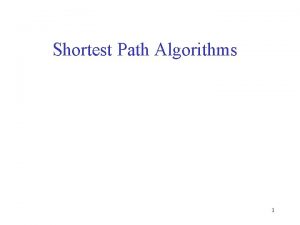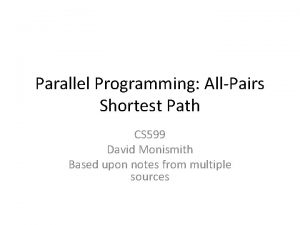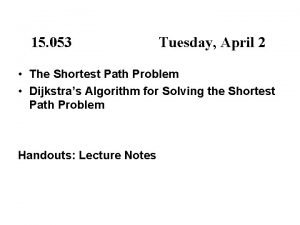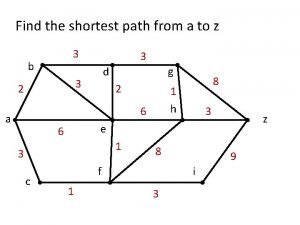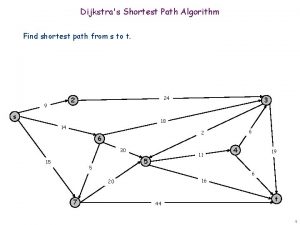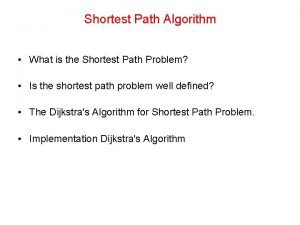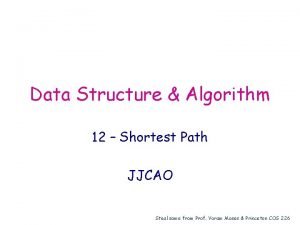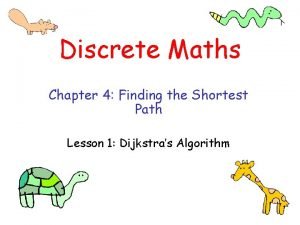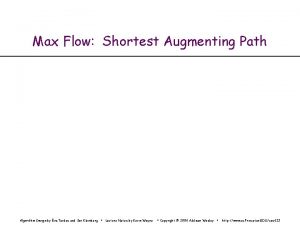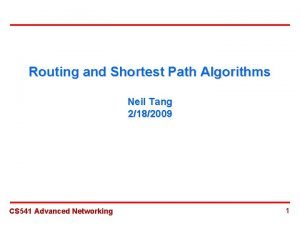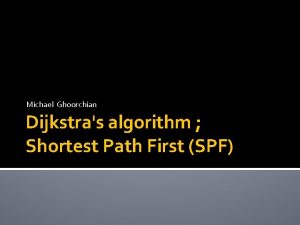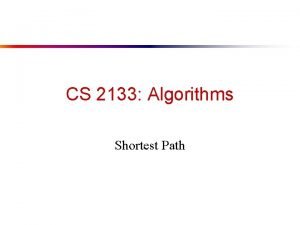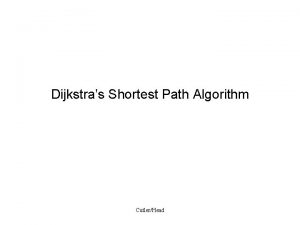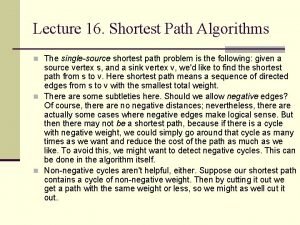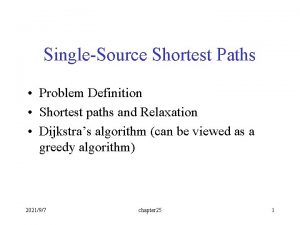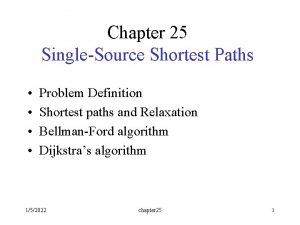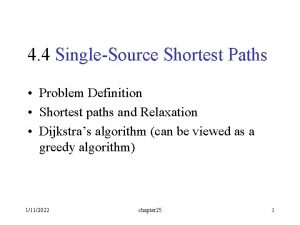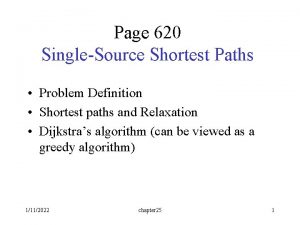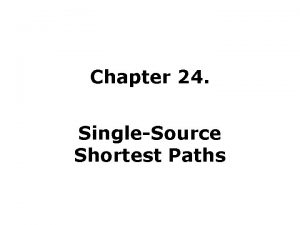CS 2133 Algorithms Shortest Path SingleSource Shortest Path







![Dijkstra’s Algorithm Dijkstra(G) B 2 10 for each v V 4 3 d[v] = Dijkstra’s Algorithm Dijkstra(G) B 2 10 for each v V 4 3 d[v] =](https://slidetodoc.com/presentation_image/08545f9b6161d799540be87aa55bb524/image-8.jpg)


![Dijkstra’s Algorithm Dijkstra(G) for each v V d[v] = ; d[s] = 0; S Dijkstra’s Algorithm Dijkstra(G) for each v V d[v] = ; d[s] = 0; S](https://slidetodoc.com/presentation_image/08545f9b6161d799540be87aa55bb524/image-11.jpg)



- Slides: 14

CS 2133: Algorithms Shortest Path

Single-Source Shortest Path l Problem: given a weighted directed graph G, find the minimum-weight path from a given source vertex s to another vertex v n n n “Shortest-path” = minimum weight Weight of path is sum of edges E. g. , a road map: what is the shortest path from Chapel Hill to Charlottesville?

Shortest Path Properties l Again, we have optimal substructure: the shortest path consists of shortest subpaths: n Proof: suppose some subpath is not a shortest path u There must then exist a shorter subpath u Could substitute the shorter subpath for a shorter path u But then overall path is not shortest path. Contradiction

Shortest Path Properties Define (u, v) to be the weight of the shortest path from u to v l Shortest paths satisfy the triangle inequality: (u, v) (u, x) + (x, v) l “Proof”: x l u v This path is no longer than any other path

Shortest Path Properties l In graphs with negative weight cycles, some shortest paths will not exist (Why? ): <0

Relaxation l A key technique in shortest path algorithms is relaxation n Idea: for all v, maintain upper bound d[v] on (s, v) Relax(u, v, w) { if (d[v] > d[u]+w) then d[v]=d[u]+w; } 5 2 9 5 2 Relax 5 2 6 Relax 7 5 2 6

Dijkstra’s Algorithm Here we assume no negative edge weights l Similar to breadth-first search l n l Grow a tree gradually, advancing from vertices taken from a queue Also similar to Prim’s algorithm for MST n Use a priority queue keyed on d[v]
![Dijkstras Algorithm DijkstraG B 2 10 for each v V 4 3 dv Dijkstra’s Algorithm Dijkstra(G) B 2 10 for each v V 4 3 d[v] =](https://slidetodoc.com/presentation_image/08545f9b6161d799540be87aa55bb524/image-8.jpg)
Dijkstra’s Algorithm Dijkstra(G) B 2 10 for each v V 4 3 d[v] = ; A D d[s] = 0; S = ; Q = V; 5 1 C while (Q ) u = Extract. Min(Q); Ex: run the algorithm S = S {u}; for each v u->Adj[] if (d[v] > d[u]+w(u, v)) d[v] = d[u]+w(u, v); Relaxation Note: this Step is really a call to Q->Decrease. Key()

Dijkstra’s Algorithm Dijkstra(G) How many times is for each v V Extract. Min() called? d[v] = ; d[s] = 0; S = ; Q = V; while (Q ) How many times is u = Extract. Min(Q); Decrease. Key() called? S = S {u}; for each v u->Adj[] if (d[v] > d[u]+w(u, v)) d[v] = d[u]+w(u, v); What will be the total running time?

Dijkstra’s Algorithm Dijkstra(G) How many times is for each v V Extract. Min() called? d[v] = ; d[s] = 0; S = ; Q = V; while (Q ) How many times is u = Extract. Min(Q); Decrase. Key() called? S = S {u}; for each v u->Adj[] if (d[v] > d[u]+w(u, v)) d[v] = d[u]+w(u, v); A: O(E lg V) using binary heap for Q Can acheive O(V lg V + E) with Fibonacci heaps
![Dijkstras Algorithm DijkstraG for each v V dv ds 0 S Dijkstra’s Algorithm Dijkstra(G) for each v V d[v] = ; d[s] = 0; S](https://slidetodoc.com/presentation_image/08545f9b6161d799540be87aa55bb524/image-11.jpg)
Dijkstra’s Algorithm Dijkstra(G) for each v V d[v] = ; d[s] = 0; S = ; Q = V; while (Q ) u = Extract. Min(Q); S = S {u}; for each v u->Adj[] if (d[v] > d[u]+w(u, v)) d[v] = d[u]+w(u, v); Correctness: we must show that when u is removed from Q, it has already converged

Correctness Of Dijkstra's Algorithm p 2 u s p 2 l l l x y Note that d[v] (s, v) v Let u be first vertex picked s. t. shorter path than d[u] Let y be first vertex V-S on actual shortest path from s u n n d[u] > (s, u) d[y] = (s, y) Because d[x] is set correctly for y's predecessor x S on the shortest path, and When we put x into S, we relaxed (x, y), giving d[y] the correct value

Correctness Of Dijkstra's Algorithm p 2 u s p 2 l l x y Note that d[v] (s, v) v Let u be first vertex picked s. t. shorter path than d[u] > (s, u) Let y be first vertex V-S on actual shortest path from s u d[y] = (s, y) d[u] > (s, u) = (s, y) + (y, u) (Why? ) = d[y] + (y, u) d[y] But if d[u] > d[y], wouldn't have chosen u. Contradiction.

The End
 Shortest path from source to destination in weighted graph
Shortest path from source to destination in weighted graph Mincost flow
Mincost flow Dijkstra's shortest path algorithm pseudocode
Dijkstra's shortest path algorithm pseudocode Find the shortest distance
Find the shortest distance Find the shortest path from a to z
Find the shortest path from a to z Shortest path
Shortest path Define shortest path problem
Define shortest path problem Does dijkstra work with negative edges
Does dijkstra work with negative edges Shortest path to get food
Shortest path to get food Single source shortest path in c
Single source shortest path in c Shortest path in discrete mathematics
Shortest path in discrete mathematics Augmenting path algorithm
Augmenting path algorithm Neil tang
Neil tang Dijkestra
Dijkestra Widest path algorithm
Widest path algorithm
